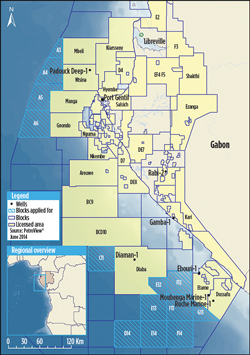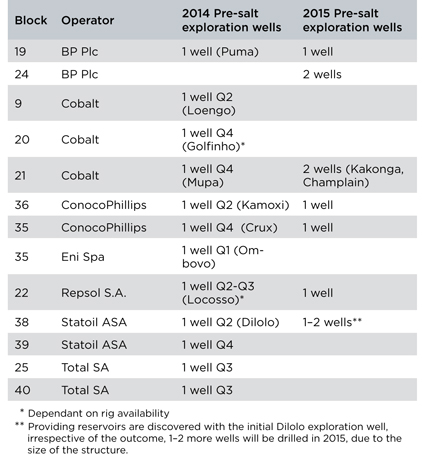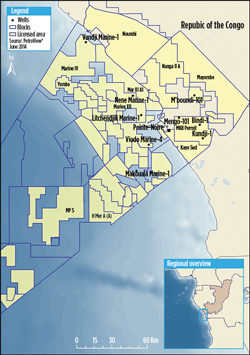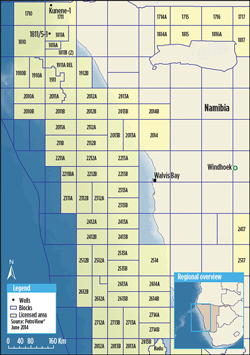|
 |
| The two-year-old SSV Catarina semisubmersible is drilling pre-salt exploration wells offshore Angola for Cobalt International Energy (photo courtesy of Cobalt); Eni has been operating in Congo since 1968, and now produces from a variety of conventional offshore fields like the facility pictured. Eni also operates the Marine XII Block, where it struck a 1.2-Bbbl pre-salt discovery in shallow water; Chariot Oil & Gas contracted the Maersk Deliverer drillship to test the Tapir South pre-salt prospect in the Namibe basin of Namibia. Although the well failed to find commercial resources, Chariot has been able to identify follow-on prospects (photo courtesy of Maersk Drilling). |
|
Since the discovery of large pre-salt fields offshore Brazil, explorers have identified analogous basins offshore West Africa as having pre-salt potential. In recent years, countries, such as Angola, Gabon, Congo and Namibia, have geared up for pre-salt exploration in their deepwater areas. Pre-salt-focused rounds have encouraged the industry to participate in these frontier plays, as have improvements in imaging techniques and deepwater technologies.
REGIONAL OVERVIEW
The term “pre-salt” defines geological layers laid down prior to the Aptian salt deposition. The petroleum formed from organic-rich sediments layed down in the pre-salt is thought to have been trapped by this regionally extensive salt layer, creating a simple petroleum system–play concept targeted by oil and gas companies today. A series of analogous basins can be tracked on both sides of the Atlantic Ocean.
The stratigraphies of the basins along West Africa are not identical and do not match their conjugate pairs in South America; however, there are general similarities. The stratigraphy can be divided into two main phases, rift and sag. Rifting occurred as a result of continental extension between Africa and South America, during which non-marine sediments and organic-rich petroleum source rocks were deposited. As active extension stopped, thermal contraction and sedimentary loading enabled subsidence, known as the sag phase. These deposits were overlain by Aptian salt sequences, which accumulated through repeated cycles of marine incursion into restricted basins and shallow seas. This forms the general character pre-salt geology, with the Aptian salt deposition marking a distinct separation of pre-rift and post-rift domains.
The West African pre-salt is found both onshore and offshore, from the southern edge of the Niger Delta, down to the Walvis Ridge offshore northern Namibia. Pre-salt exploration in West Africa began in the 1950s, with multiple onshore and shallow-water discoveries made since this time. Renewed industry interest in Africa’s pre-salt began to focus within the deepwater play following the Lula discovery in Brazil’s analogous basin in 2006.
Historically, the technology available to accurately image the pre-salt was not available, making it difficult to identify pre-salt prospects and leads. Pre-salt drilling also continues to be more expensive than conventional drilling, due to the properties of the salt layer and the increased depth required from each well, posing significant technical challenges. In West Africa, these challenges restricted deep, offshore pre-salt exploration.
As the world’s fifth-largest oil discovery, Brazil’s Lula field changed this. The industry’s interest in deepwater pre-salt plays piqued, drawing attention to West Africa as a conjugate margin to Brazil.
ANGOLA
Angola’s oil industry began more than 20 years before its independence in 1975, with sporadic drilling and small oil discoveries onshore. It wasn’t until the drilling of the onshore Benfica-2 well in January 1955 that Angola discovered its first commercial oil field. Benfica field was brought into production in November 1956, marking the beginning of oil production in this country.
In 1968, Angola’s first offshore oil field, Malongo, was discovered and, by 1973, oil had surpassed coffee as Angola’s largest export. By 1996, Angola had become a modest-sized oil-producing country, averaging 700,000 bpd, primarily from offshore fields.
In 1996, Elf Aquitaine (now Total) discovered Girassol oil field, which successfully opened up a new offshore post-salt play. Girassol is estimated to contain recoverable reserves of between 700 MMbbl and 800 MMbbl of oil, with the reservoirs found in post-rift sandstone conglomerates of Oligocene and Miocene age. Follow-on discoveries that targeted this play were also successful. This resulted in operators focusing on the post-salt play, from which most Angolan production now comes. Pre-salt exploration was not an industry focus until recent years.
Angola’s upstream industry is run by national oil company (NOC) Sonangol. As the sole concessionaire for exploration in Angola, Sonangol has, since 2005, licensed many of its blocks through announced international licensing rounds. IOC exploration has focused on the Lower Congo basin and in the shallow waters of the Kwanza basin. Following Brazil’s Lula discovery in 2006, interest in the Kwanza basin and deepwater opportunities increased, and Sonangol announced plans to launch a licensing round.
In 2010, Sonangol awarded a number of pre-salt blocks after inviting more than 20 companies to present their intentions to bid for licenses and negotiate for deepwater acreage. Proposals were received in December 2010, and winners were announced in January 2011. The round originally included six blocks. However, upon award, 11 blocks were offered, and contracts were finalized and signed during December 2011, Fig. 1. Successful companies included many that already held acreage positions in Angola.
 |
| Fig. 1. Blocks on offer in the 2013 Gabon licensing round. |
|
The licenses included a number of pre-salt-specific work commitments introduced to encourage exploration and development. During the initial five-year exploration phase, generally two pre-salt exploration wells are expected to be drilled in each block. Three companies—Cobalt, Maersk Oil and Petrobras Oil & Gas BV—have led the way in exploring the Kwanza basin’s deepwater potential through existing assets.
Maersk made a significant, deep offshore discovery within the Angolan pre-salt. Maersk acquired two blocks, 8 and 23, in 2006. In June 2011, Maersk spudded its first pre-salt exploration well, Azul-1, in Block 23 of the Kwanza basin. The well was drilled to a depth of 5,334 m. It recovered two good-quality oil samples, with results suggesting a potential flow capacity greater than 3,000 bpd.
Shortly after, Cobalt announced the successful Cameia-1 discovery. Cobalt first acquired Blocks 9 and 21 in 2009, outside of the normal licensing rounds, and later Block 20 in the 2010 round. Prior to Cobalt acquiring these blocks, post-salt prospects had been targeted in Blocks 9 and 21 by ChevronTexaco and BHP Billiton. These licenses were relinquished in 2001 and 2002.
Cobalt took a new approach by targeting the unexplored pre-salt play. Following the reprocessing of seismic, and conducting of new seismic surveys, the operator spudded its first pre-salt exploration well, Cameia-1, in Block 21 during August 2011. In February 2012, Cobalt announced that Cameia was a discovery, with a 360-m gross continuous hydrocarbon column. Cobalt has since drilled four further pre-salt exploration wells with a 100% success rate, including Lontra-1 and Orca-1 on Block 20, and Mavinga-1 and Bicuar-1A on Block 21.
In 2012, Petrobras spudded the pre-salt Ogonga-1 well in deepwater Block 26. The well encountered difficulties after penetrating layers of hard mineral-rich rock beneath the salt, which impacted drilling costs. The well reportedly discovered hydrocarbons but was abandoned as a dry hole, due to high CO2 content.
With the end of the first exploration period approaching for the blocks licensed in the 2010 round, a number of companies are fulfilling pre-salt drilling commitments, buoyed by the success of Cobalt and Maersk, Table 1.
| Table 1. Announced, pre-salt-focused drilling commitments offshore Angola. |
|

|
GABON
The oil industry has been active in Gabon for over 50 years. According to the 2012 BP Statistical Energy Survey, Gabon had proved oil reserves of 3.684 Bbbl at the end of 2011, equivalent to over 40 years of current production. Gabonese production peaked in the 1990s at 370,000 bopd, and has since fallen to 240,000 bopd. The Gabonese ministry has made efforts to encourage further exploration in the underexplored, deep offshore areas through licensing rounds.
Pre-salt exploration began onshore, where many large oil fields have been discovered below the salt, some of which are among the country’s best producers. Shell’s pre-salt Gamba field began producing in 1967. Its Rabi Kounga field, the largest in the country at 440 MMbbl of oil, began producing in 1989, reaching 150,000 bpd.
Vaalco Energy has seen a number of shallow, offshore pre-salt successes on its Etame Marin Block, including Etame field, which was discovered in 1998 and began producing in 2002. Ebouri field was found in 2003 and came online in 2009. Also, Avouma field was discovered in 2004 and came online in 2007.
Recent finds and technological advances have made producing from existing pre-salt discoveries more attractive. Two finds on the Dussafu Marin permit, Moubenga and Walt Whitman, are under consideration for production. Moubenga-1 was drilled by Elf Aquitaine (now Total) in 1981 and tested a maximum 2,730 bopd from the Dentale formation. Walt Whitman-1, drilled by Amoco (now BP) in 1995, encountered a 17-m oil column in the Gamba sandstone. The addition of the recent Ruche (2011) and Tortue (2013) discoveries may provide sufficient reserves for a cluster development, now operated by Harvest Natural Resources.
Tracts in Gabon are awarded through licensing rounds—of which there have been 10 to date—and also through direct negotiation. Gabon initially attempted to launch its 10th Licensing Round in May 2010, offering 42 offshore blocks, covering approximately 118,000 km2 of prospective, deepwater pre-salt play. This was the first round since 1999. Yet, after a number of delays, the round was cancelled in October 2010, following the Deepwater Horizon disaster in the Gulf of Mexico. In addition, new legislation was still under design in response to trade union demands for a limit on the number of foreign workers in Gabon’s oil industry. It was decided that blocks would, instead, be left open for direct negotiations with interested parties, once new legislation was in place.
The licensing round was re-launched in 2013 under new Gabonese Oil Minister Etienne Ngoubou. The Ministry of Petroleum invited bids from selected companies for 43 available blocks. Applications were received for 18 offshore blocks, and successful bids were announced for 13 tracts in October 2013. The 13 blocks cover underexplored areas, in water depths between 200 and 4,000 m, with a total area of 26,770 km2, Fig. 1.
The announcement coincided with postponement of changes to Gabon’s oil laws planned for that year. More transparent and rigid oil laws are anticipated to come into effect from the start of 2015. A new company was set up to publish company and governmental data on production volumes, tax contributions, reserves estimates and data on permits. The newly created Gabon Oil Company is also entitled to take a stake of up to 15% in new blocks owned by other companies.
While onshore and shallow-water pre-salt exploration began in the 1960s, it was not until recently that companies ventured into Gabon’s underexplored deep waters. New seismic data were acquired in 2009 before the scheduled beginning of the license round. Total’s 2013 Diaman-1B well was drilled on the Diaba Block and was the first deep offshore well to significantly de-risk this play.
Ophir drilled the Padouck Deep-1 well in March 2014 on the Ntsina Block. The well did not encounter significant hydrocarbon shows, in line with reports of the key pre-drill risks being trap and seal integrity. Ophir followed Padouck Deep with Okala-1, which was drilled in 790 m of water, targeting gross resources of 354 MMboe in Cretaceous sands within the pre-salt section. However, the prospect was announced as dry in June 2014 after encountering a thick Aptian salt section.
Exploration in the deeper offshore, pre-salt Gabon basin is ramping up, as operators complete seismic surveys. At the time of writing, Shell is drilling the N’Komi Marin-1 pre-salt well on the BC-9 permit and may drill a second well on BC-9, or on neighboring Block BC-10. PuraVida Energy is farming out a portion of its Nkembe Block in preparation for drilling, having completed 3D seismic. Perenco is also expected to drill the Sputnik East HPHT prospect on its Arouwe Block in the coming months. It will target mean resources of 206 MMboe.
REPUBLIC OF CONGO
Like many West African countries, Congo’s oil and gas industry has had a long history. The country’s first oil field, Pointe Indienne, was discovered in 1957, and began producing in 1960. It reached peak output in 1962 at over 2,500 bopd.
Congo struck its first pre-salt discoveries in the 1970s, onshore and in shallow waters. Agip (now Eni) drilled the shallow-water Vandji Marine-1, and Elf Congo (now Total) drilled the Litchendjili Marine-1, both in 1972. Elf also hit a discovery with Mengo-101 onshore in 1979. The Mengo-101 pre-salt discovery was closely followed by the nearby Kundji-1 and Bindi-1 pre-salt discoveries in 1980 and 1982, respectively.
Mengo, Kundji and Bindi fields make up what is now known as the MKB permit. In 2011, Panoro Energy ASA estimated MKB’s gross oil-in-place at over 1 Bbbl. However, recovery from the reservoirs is low. Elf originally began producing from the MKB fields during the 1980s and subsequently abandoned them in 1992. The Congolese state oil company, La Société Nationale des Pétroles du Congo (SNPC), now operates the permit and has drilled eight more wells on Kundji.
KUN-4bis and KUN-5 were drilled during 2009 and hydraulically fractured. These wells were put on a long-term production test in 2010, where they produced over 600 bopd, more than twice the rate seen from the original KUN-1 well. In September 2011, pilot production commenced, consisting of six wells. The last of the six, KUN-206, was completed and began producing late in 2012. Gross production from Kundji amounted to approximately 33,000 bbl in third-quarter 2012. SNPC is looking to attract new partners, to further develop the field.
The onshore pre-salt M’Boundi field was discovered by Maurel et Prom in 2001 with P50 reserves of over 260 MMbbl and began producing in 2002. Since then, over 90 wells have been drilled. Eni took over operatorship in 2007, partnered with SNPC and Tullow. The field has produced at rates of over 56,000 bopd and 100 MMcfgd.
Alfred Charles Sockarth, head of SNPC’s upstream operations, has said that Congo plans to award around 10 onshore and offshore oil blocks in a new licensing round this year. He stated that three blocks have already been awarded in the Cuvette basin, and a further seven remain. Several shallow-water areas are also reported to be made available, including blocks previously abandoned.
The government’s fiscal terms are also becoming more attractive to companies with a “super profit sharing” system in place, where the state’s take is set against profits made above a certain oil price. Congo’s infrastructure is also well-developed, compared to nearby countries. The vast majority of exploration and production occurs offshore or near the coast, Fig. 2.
 |
| Fig. 2. Map showing the Republic of Congo’s current acreage. |
|
In February 2014, Eni discovered oil in Congo’s pre-salt with its Nene Marine-1 well in the shallow, offshore Marine XII Block. The most recent exploration well, Nene Marine-3, was drilled in 28 m of water and confirmed the extension of the reservoir previously discovered by Nene Marine-1 and Nene Marine-2, drilled in 2012. Nene Marine-3 flowed at over 5,000 bpd of 36°API oil during the production test. The wells encountered wet gas and light oil. Eni estimates that Nene Marine field contains 1.2 Bbbl of oil and 30 Bcm of gas-in-place. Combined with neighboring Litchendjili field, the block reportedly contains 2.5 Bboe in-place. Eni anticipates first oil in 2016.
Nene Marine is the first major pre-salt discovery in the shallow waters offshore Congo, to date. Soco previously drilled the Mindou Marine-1 well in the neighboring Marine XI Block in late 2011. However, the well did not encounter oil shows in the targeted pre-salt section. Viodo field, also on the Marine XI Block, was first discovered in the late 1980s. Soco had success re-drilling the prospect in 2009 with Viodo Marin-4, which flowed at 2,600 bopd and 7 MMcfgd. Soco also saw limited success in their Marine XIV Block in 2011 with the Makouala Marine-1. The well encountered hydrocarbons in the pre-salt, but the reservoirs could not provide commercial flowrates.
NAMIBIA
Namibia is one of Africa’s last frontiers for hydrocarbon exploration. The oil industry, prior to Namibia’s independence in 1990, was almost non-existent, due in part to the country’s previous administrative position. Initial exploration began during the late 1960s and early 1970s. Only one well, Kudu 9A-1, was drilled during that time by Chevron. The well was spudded on Dec. 13, 1973, and discovered gas before reaching a TD of 4,536 m. Two main sandstone reservoirs of 52 and 24 m were discovered in Barremanian-aged aeolian sandstones. Due to high formation pressure, it was not possible to complete a DST, but results obtained indicated a flow potential of up to 200 MMcfgd. The well was subsequently P&A’d on May 14, 1974.
Two appraisals, Kudu-9A-2 (1987) and Kudu-9A-3 (1988), were drilled by Swakor, the predecessor to Namibia’s current NOC, Namcor. The first well, Kudu-9A-2, encountered low permeability within the reservoir sections and was deemed non-productive. The well was P&A’d on Dec. 26, 1987. On Jan. 20, 1988, the Kudu 9A-3 appraisal was spudded, reaching a TD of 4,522 m. It successfully appraised the Kudu discovery, and was P&A’d in April 1988 as a gas well. These results were used to launch Namibia’s first licensing round in 1991–1992.
There have been 24 wells drilled offshore Namibia to date; seven appraisal wells within Kudu, and 17 exploration wells along a 1,200-km coastline, making it a largely underexplored country. After independence, the first exploration licensing round was held in 1991–1992, with five licenses being awarded. Three more licensing rounds were held through 2004, with only four blocks awarded in total.
In 1999, the Namibian government invited international oil companies to apply for petroleum exploration licenses under an open licensing system. Although there was a lack of activity initially, interest has increased during the last four years. At the time of writing, 63 blocks have been licensed offshore Namibia, Fig. 3. Small independents dominate Namibia’s licensing. Increasing interest within the country has led to a rise in recent farm-in activity, including the entrance of such companies as BP, Shell and Repsol.
 |
| Fig. 3. Namibia’s current acreage. |
|
Namibia has similar tectonic evolution and petroleum systems as the proved basins within Brazil and Angola. However, to the south of the Walvis Ridge, Namibia is characterized by the lack of an Aptian salt layer. Therefore, exploration within pre-salt is restricted to the northernmost Namibe basin.
Two wells have been drilled within the Namibe basin. Kunene-1, spudded in April 2008, became the first offshore well in Namibia for over 10 years. Drilled by Sintezneftegaz CJSC, it reached a TD of 5,050 m, but did not encounter the predicted Aptian-age reservoirs. The well did encounter significant shallow and deep hydrocarbon shows. It was classified as a tight hole by the Namibian government. EnerGulf Resources, a partner in the block, stated that it is unlikely to be a commercial producer.
Chariot drilled the second well, Tapir South. It was the first well in Chariot’s drilling campaign offshore Namibia, spudded in April 2012, and targeting pre-salt turbidite and carbonate reservoirs. The well encountered 173 m of Cretaceous reservoir sands, as well as carbonate intervals. Despite oil indications, the reasons for the prospect’s failure have varied in interpretation. The well was subsequently P&A’d in May 2012.
Interest in Namibia’s pre-salt within the Namibe basin continues, with companies such as Chariot and EnerGulf announcing follow-on, drill-ready prospects, based upon the initial two wells. In Block 1711, north of Walvis Ridge, EnerGulf is assessing three potential hydrocarbon systems involving both post- and pre-salt plays. Following the Kunene-1 failure in 2008, the company identified follow-on prospects. Kunene Deep and Kunene South are pre-salt Lower Cretaceous-aged prospects, sourced locally from Lower-Cretaceous-age synrift lacustrine source rocks. In June 2013, the block consortium was granted a new petroleum agreement for Block 1711, which included a one-well commitment to be drilled within the first four-year exploration period.
Chariot holds a number of tracts within Namibia, including Blocks 1811A and 1811B, which are part of its northern acreage on the boundary of Walvis Ridge. Following the drilling of the Tapir South well, Chariot subsequently undertook petrophyscial and seismic reprocessing, based upon the well results, to understand where oil-charged sands might exist. The firm has identified the Tapir North and Zamba prospects as follow-on pre-salt targets in these blocks.
CONCLUSIONS
West Africa’s cretaceous pre-salt play has all the necessary working parts of the petroleum system—good, extensive source rocks; clastic and carbonate reservoirs; salt and mud seals; and structural and stratigraphic traps. The play, itself, is not a new idea, with onshore African discoveries having been made in the pre-salt over the past five decades in Congo, Gabon and Angola.
Better seismic and drilling technologies, coupled with a drive to make new finds, are pushing companies to explore West Africa’s deepwater pre-salt play. Recent finds, such as Diaman-1B in Gabon, and the Azul and Cameia discoveries in Angola, have helped to de-risk the frontier play and present encouraging signs for future exploration. 
|







